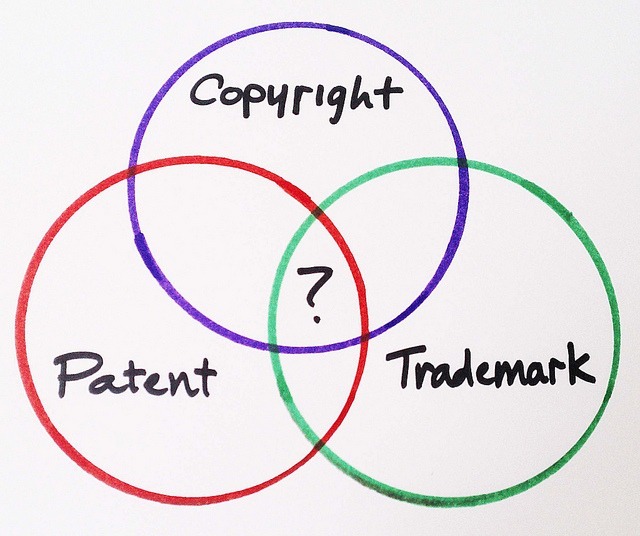

We have all seen the R in a circle on brand names. But what does that actually mean? What about the little C, or the TM? Here is a closer look at the different types of patents and their specificities.
According to Wikipedia, a patent is a set of exclusive rights granted by a sovereign state to an inventor or assignee for a limited period of time in exchange for detailed public disclosure of an invention. A word, phrase, symbol and/or design that identifies and distinguishes the source of the goods of one owner from those of others is called a trademark, whereas a word, phrase, symbol, and/or design that identifies and distinguishes the source of a service rather than the goods is called a service mark. However, it should be noted that the term "trademark" is used to refer to both trademarks and service marks.
All marks do not have to be registered, but registration notifies the public of the registrant's legal ownership of the mark worldwide, and the exclusive right to use the mark on or in connection with the registrant’s goods or services.
Finally, a copyright protects an original artistic or literary work, whereas a patent protects an invention.
For example, if you invented a new kind of smart phone, you would want to apply for a patent to protect this invention. You would probably want to register a trademark to protect the name of the smart phone, and register the copyright for the TV advertisement to market the product. If you register a domain name with GoDaddy.com, this would not give you any trademark rights and you could later be required to surrender it if it infringes on someone else's trademark rights.
However, trademark owners can license them to others for a fee. For example, the Lego Group purchased a license from Lucas film in order to be allowed to launch “Lego Star Wars”.
The different types of trademarks
A trademark may be designated by the following symbols:
• ™ (the "trademark symbol", which is comprised of the letters "TM", for an unregistered trademark, a mark used to promote or brand goods)
• ℠ (which is the letters "SM" in superscript, for an unregistered service mark, a mark used to promote or brand services)
• ® (the letter "R" surrounded by a circle, for a registered trademark)
The first trademark legislation was passed by the Parliament of England under the reign of King Henry III in 1266, which required all bakers to use a distinctive mark for the bread they sold. Löwenbräu, the Munich-based beer, claims use of its lion mark since 1383.
While ™ can be used commonly, ® can only be used by the owner of a mark or its third party legal representatives following registration with the relevant authority. The proper manner to display either symbol is immediately following the mark, usually in capitals and in superscript.
Proprietary rights and protection against counterfeiting
Unauthorized use of trademarks by producing and trading counterfeit or fake consumer goods is known as trademark infringement or brand piracy. Wikipedia cites that “The owner of a trademark will lodge legal action against trademark infringement. Most countries require formal registration of a trademark as a precondition for pursuing this type of action. The United States, Canada and other countries also recognize common law trademark rights, which means action can be taken to protect an unregistered trademark if it is in use.”
Proprietary rights in relation to a trademark may be established through use in the market or through registration of the mark with the trademarks office or trademarks registry. However if a trademark owner does not hold registrations for their marks in certain jurisdictions, the extent to which the owner will be able to enforce rights through trademark infringement proceedings will be limited. In cases of dispute, this disparity of rights is often referred to as "first to file" as opposed to "first to use.”
There are examples of countries that have patented products made in developing countries where neither the product, the materials nor the know-how come from that particular country. For instance, in the case of Japan & Kikoy UK Ltd, Japan filed a patent for a product which is made in Kenya and sold by Kikoy UK Ltd. Japan owns the patent as it was the "first to file" as opposed to Kikoy UK Ltd, who was the "first to use". Germany offers a limited amount of common law rights for unregistered marks and to gain protection, the goods or services must occupy a high position in the market — a 40% or more market share for sales in a particular class of goods or services.
A trademark can be 'abandoned' or its registration cancelled or revoked if the mark is not continuously used. By comparison, patents and copyrights cannot be 'abandoned' and a patent holder or copyright owner can enforce his rights without taking any particular action to maintain that patent or copyright. In countries where a business operates or intends to operate, it is very important to be protected in the correct classes of service or products provided.
While patents which are renewable indefinitely, trademark rights have no limited term of existence and usually granted for 7 to 20 years with worldwide protection. However, the rights to use it may be lost due to misuse or lack of use. A useful illustration of the importance of trademark protection can be found in the products we know as aspirin, nylon and elevators, which used to be protected trademarks. Now, they are everyday nouns that anyone can use.
Three reasons why it is important to register a trademark
According to Trademark Eagle UK, a leading trademark registration service, there are a few important reasons why companies should register trademarks:
1. Defensive: Avoiding Unwelcome Change
Changing the name of a company especially when you have built up a good reputation is difficult and costly. It can take a hefty budget to rebuild a renamed brand. When a logo, symbol or name is unregistered, there is always the risk that another business or competitor may register it and cause significant difficulties perhaps by legally attempting to prevent your business from operating or expanding under that name.
2. Positive: Building Value
Because of reason 1, investors always look at whether a business has trademarked its name, key products or services. Doing so is certain to positively impact the perceived value of the business and aid clarity in any merger or franchising of the business.
3. Positive: Protection
Registering a trademark ensures that your business is appropriately protected against competition. Unauthorized parties who use your trademark without authorization can damage your brand, your reputation and your business. So in effect you are building protection around your brand which will make it harder for any other business to attempt to imitate your products or goods. It is a legal way of preventing others from taking advantage of your business by trading under your name –something we see all too often in the fake luxury goods market.
Penalties of trademark infringements
According to an article by Marilyn Lindblad of Demand Media, the main legal punishments for infringement are an injunction or a monetary fine.
Injunction / Court procedure
A trademark owner can stop a competitor from using a mark that is similar to the owner's trademark by getting a court order called an injunction. The court order prohibits the infringer from continuing to use the infringing mark. If the infringer disobeys the court order, he can be held in civil contempt of court and fined. Fines for contempt of court are issued in addition to any other monetary penalties for trademark infringement. A good example of a popular trademark is Nike's logo. If another company tried to sell goods using a symbol that looked like the Nike logo, that company would be infringing on the Nike's trademark rights. Nike would therefore have grounds to take the company to court.
Monetary Fines
The owner of a trademark can sue a violator for cash damages. The amount of damages can be based on the profit made from the infringing products or the profit that the trademark owner lost because consumers bought unauthorized products instead of buying authentic products from the trademark owner. If the violator willfully infringed the trademark, the court can multiply damages by three. A violator can also be required to pay the trademark owner's legal fees and costs of the case, and these can be very costly.
Some disadvantages of trademark registration
Being a trademark owner comes with responsibilities. Firstly, the trademark owner needs to show proof of use at regular intervals. The first submission is between five and six years after registration, the second is five years later, and then the owner must renew registry every 10 years thereafter. If the owner does not file these documents on time, it could lead to the loss of the trademark. Another disadvantage for trademark owners is that they pay fees for registration and renewal. The fee depends on the number of classes of products that are covered in the application, plus other additional fees.
Luxury fakes
With many fakes coming from Asia, where 85 percent of articles seized in Europe are produced, and the increasing popularity of on-line shops that give the buyer a sense of anonymity, impunity and legality, the luxury fakes market has exploded in recent years. A buyer from Geneva who unknowingly ordered a designer fake watch on the internet. However, instead he received a bill from customs with the right amount for the watch, customs taxes plus fines (totaling to more than the exact cost of the watch) for purchasing a fake designer watch which was eventually destroyed.
To fight the scourge, the “Comité Colbert”, a group of 80 French luxury goods makers including Dior, Cartier and Remy Martin, launched a poster campaign in French airports ahead of the summer to dissuade travelers from buying fakes.
"You can call your lawyer with this telephone,'' reads one of the posters above a picture of a counterfeit Chanel mobile.
France has the toughest anti-counterfeit legislation in the world, explains Comité Colbert CEO Elisabeth Ponsolle des Portes. Simply possessing a counterfeit good is considered a crime since 1994. In France, one can be fined up to 300,000 euros and jailed for three years if caught owning counterfeit goods.
The Comité Colbert now wants to get the cooperation of banking groups and payment handlers such as MasterCard, Visa, American Express and PayPal, to track the illegal trade online.
Sources:
http://www.uspto.gov/trademarks-getting-started/trademark-basics/trademark-patent-or-copyright
https://en.wikipedia.org/wiki/Trademark
http://www.investopedia.com/terms/t/trademark.asp
http://www.cultofmac.com/392096/apple-faces-862m-fine-for-infringing-universitys-patent/
http://www.trademarkeagle.co.uk/news/why-register-a-trademark
http://businessinsides.com/trademark-advantages-disadvantages.html
http://www.insidecounsel.com/2012/05/22/gucci-wins-trademark-infringement-cases-against-guess
http://www.vogue.co.uk/news/2015/05/01/louis-vuitton-loses-damier-trademark-infringement-case-checkerboard-motif
https://www.gov.uk/government/publications/intellectual-property-offences/intellectual-property-offences
http://www.worldipreview.com/news/castel-hit-with-5m-fine-over-chinese-trademark-infringement
http://www.news.com.au/finance/business/french-luxury-brands-fight-back-against-fakes/story-fnda1bsz-1226373273750
http://ww2.cfo.com/supply-chain/2015/07/luxury-goods-counterfeit-com/
http://www.comitecolbert.com/histoire.html
Photo credit: BusinessSarah via Flickr, CC 2.0 License
This article was interesting and very well written !
It seems like the author worked as a jurist.